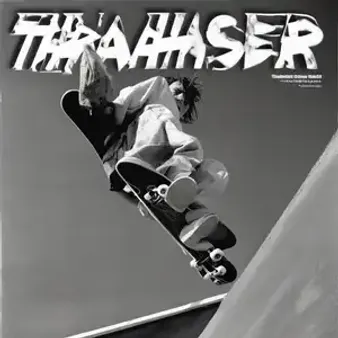Table of Contents
The world of skateboarding wouldn't be the same without Thrasher Magazine. Since its inception, it's documented the evolution of the sport, showcasing legendary skaters and groundbreaking tricks. For collectors and enthusiasts alike, first thrasher covers hold a particular allure. kizworld takes a look at these iconic pieces of skateboarding history.
Feature | Description |
|---|---|
Significance | Highly collectible, reflecting skateboarding history and culture |
Identification | Look for premiere issue dates, early logos, and distinct visual styles |
Value Factors | Rarity, condition, and historical significance influence price |
Preservation | Proper storage and handling are crucial for maintaining value |
The History and Significance of First Thrasher Covers
Birth of an Icon
Imagine a time before the internet, before Tony Hawk landed the 900, when skateboarding was more of an underground movement than a mainstream sport. That's where Thrasher Magazine comes in! It all began in 1981, in San Francisco, the birthplace of so many cool things. The very first Thrasher cover was like a beacon, calling out to all the skaters out there. It was raw, rebellious, and totally awesome. It showed the world that skateboarding wasn't just a hobby, it was a way of life.
- Coffee
- Tea
- Milk
A Window into Skateboarding's Soul
Think of each early Thrasher cover as a snapshot in time, capturing the spirit of skateboarding as it evolved. The graphics were bold, the photography gritty, and the featured skaters quickly became legends. Finding a first thrasher cover is like owning a piece of that history, a reminder of the sport's raw energy and rebellious roots. It's no wonder these magazines are so sought after by collectors and skateboarding enthusiasts - they're like artifacts from a bygone era!
Company | Contact | Country |
|---|---|---|
Alfreds Futterkiste | Maria Anders | Germany |
The History and Significance of First Thrasher Covers
Identifying a First Thrasher Cover: Key Features
Embracing the OG Style
Alright, imagine you're on a treasure hunt for the very first Thrasher cover. It's like finding a vintage skateboard backpack - super cool and a blast from the past! The debut issue hit the shelves in January 1981, and trust me, it had a look of its own. Think bold, in-your-face graphics with a punk rock vibe. The logo was still evolving, so don't expect the iconic flaming Thrasher masthead we all know and love today. It was simpler, bolder, with a raw energy that screamed "skateboarding."
Take, for example, that first cover. It featured a black and white photo of a skater hitting a gnarly air off a ramp, all captured with this gritty, almost DIY aesthetic. Early covers often showcased black and white photography, which adds to their vintage charm. And speaking of charm, keep an eye out for the old-school fonts and layouts. They might seem simple now, but back then, they were revolutionary, breaking all the rules of traditional magazine design.
Feature | Description |
|---|---|
Logo | Simple, bold, pre-dates the iconic flaming masthead |
Photography | Often black and white, gritty, DIY aesthetic |
Layout | Simple, bold fonts, unconventional design |
Spotting the Telltale Signs
Now, let's talk about some dead giveaways that you've stumbled upon a genuine first edition Thrasher cover. One thing to look out for is the issue date, which, as we know, is January 1981. But here's the catch: early issues didn't always have barcodes on the cover. They were all about that raw, underground feel, remember? Another thing to remember is that early Thrasher was much thinner than later issues. We're talking about a time before glossy pages and tons of ads. It was pure skateboarding content, straight from the heart.
One time, I was at a flea market, and I swear I saw a first edition Thrasher just sitting there in a stack of old magazines. My heart skipped a beat! I quickly checked the date and, sure enough, it was from January 1981. But as I got closer, I noticed the cover felt a bit too thick and glossy. Turns out it was a reprint, which are cool, but nothing beats the real deal. It's all about those subtle details, my friend!
- Issue date: January 1981
- Barcodes: Often absent from early issues
- Thickness: Significantly thinner than later issues
Identifying a First Thrasher Cover: Key Features
The Price of Nostalgia: What Makes First Thrasher Covers Valuable?
Okay, so you've got your hands on a first Thrasher cover, or maybe you're thinking about starting your search. You're probably wondering, "What's it worth?" Well, it's like finding a rare Tony Hawk skateboard from the 80s – the older and more pristine, the more valuable it becomes. First and foremost, rarity is key. We're talking about a magazine that's over 40 years old! Many copies have been lost, tossed, or loved to pieces. Finding one in any condition is a score, but a pristine copy? Now you're talking serious collector's item!
Then there's the condition. Just like that vintage skateboard, a first Thrasher cover is way more valuable if it's been well-preserved. We're talking about crisp pages, no tears, no fading, and definitely no missing staples! It's like finding a time capsule, perfectly preserved from the golden age of skateboarding. A mint condition first issue can fetch a pretty penny, especially among die-hard collectors. I once saw a near-mint copy go for a few hundred bucks online!
Condition | Description | Potential Value |
|---|---|---|
Mint | Like new, no flaws | Highest |
Near Mint | Minor shelf wear, otherwise excellent | Very Good |
Very Good | Slight wear, no major damage | Good |
Good | Noticeable wear, may have minor tears or creases | Fair |
Fair | Significant wear, may have tears, creases, or fading | Lower |
Preserving a Legacy: Caring for Your Collector's Item
Now, let's say you've got your hands on a valuable first Thrasher cover. You wouldn't leave a vintage WKND skateboard out in the rain, would you? These magazines are like pieces of history, and they deserve to be treated with care! First things first, keep it away from direct sunlight, heat, and moisture. Those are the enemies of paper! A cool, dry place is ideal for storage.
And here's a pro tip: consider storing it in an acid-free bag or sleeve. This helps prevent yellowing and deterioration. Trust me, your future self will thank you! Remember, a well-preserved first Thrasher cover isn't just a magazine; it's a piece of skateboarding history that you get to hold onto. Who knows, maybe someday it'll be a treasured family heirloom, passed down through generations of skaters!
- Store in a cool, dry place away from direct sunlight.
- Use acid-free bags or sleeves for protection.
- Handle with clean hands to prevent oil and dirt transfer.
Collecting and Preserving First Thrasher Covers
The Thrill of the Hunt
Collecting first Thrasher covers is like being a skateboarding archaeologist! It's like searching for those rare Tony Hawk skateboards everyone wants. You can find them in unexpected spots! Think old bookstores, online marketplaces, even garage sales. It's a total rush when you stumble upon one, especially if it's in good shape. I once found a 1982 issue tucked away in a box of old comics at a flea market. It wasn't perfect, had some wear and tear, but it was a piece of history!
Don't be afraid to haggle a bit when you're buying. You never know, the seller might be cool about it. But remember, be respectful! And always check the condition before you buy. Look for tears, fading, or missing pages. Once you've got your treasure, you'll want to keep it safe.
Where to Find First Thrasher Covers | Tips |
|---|---|
Online Marketplaces (eBay, etc.) | Check seller ratings, ask for detailed photos |
Bookstores (especially used bookstores) | Be patient, browse carefully |
Garage Sales & Flea Markets | Go early for the best finds, haggle politely |
Antique Shops | Don't be afraid to ask if they have any hidden gems! |
Protecting Your Piece of Skate History
Think of your Thrasher covers like that awesome WKND skateboard you wouldn't want to scratch. You gotta protect 'em! A clear plastic sleeve is your best friend. It'll keep dust, spills, and grubby fingers at bay. Store your collection upright, like books on a shelf. And remember that sunlight is the enemy! It can fade those vibrant covers faster than a kickflip. Keep 'em in a cool, dry place, and they'll stay rad for years to come.
You know, collecting these magazines isn't just about owning cool stuff. It's like holding a piece of skateboarding's story. Each cover is a window into the past, showing how the sport has changed and evolved. Plus, it's just plain fun to have a collection that reflects your passions!
- Online Marketplaces (eBay, etc.)
- Bookstores (especially used bookstores)
- Garage Sales & Flea Markets
- Antique Shops
Collecting and Preserving First Thrasher Covers
Final Thought
First Thrasher covers are more than just magazine covers; they're pieces of skateboarding history. They capture the raw energy, rebellious spirit, and evolution of this iconic sport. Whether you're a seasoned collector or just starting, the hunt for these covers is an exciting journey into the heart of skateboarding culture.